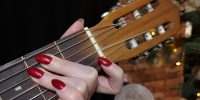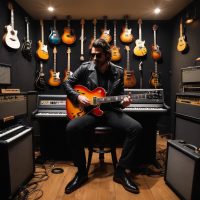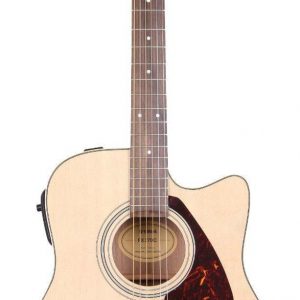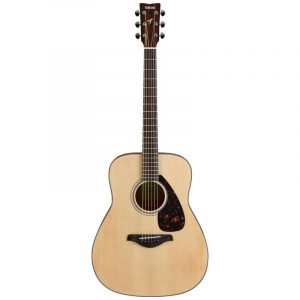Yamaha FG840
$347.99
Get ready for an unforgettable acoustic experience with Yamaha FG840 – the acoustic guitar that provides comfort, power, and rich sound for all types of players.
Compare
Description
The Yamaha FG840 acoustic guitar is one of the most popular models from the brand’s FG series. It’s a well-balanced, mid-priced instrument that is perfect for intermediate to advanced players. The FG840 is an upgrade to the popular FG830 model with additional features to enhance both the tone and playability.
Sound Quality
The FG840 produces a warm and balanced sound that is ideal for both strumming and fingerpicking. It has a solid spruce top that gives the guitar a rich and vibrant tone. The back and sides are made of rosewood, which adds depth and warmth to the sound. It has a loud and clear projection that makes it an excellent guitar for live performances.
Design and Build Quality
The FG840 has a classic dreadnought design with a glossy finish that looks classy and elegant. The neck is made of mahogany and has a slim profile, making it easy for players with small hands to play. The fretboard is made of rosewood, and the frets are expertly finished, making it comfortable to play for long durations.
The guitar’s bridge is made of rosewood, and the saddle is made of urea—this combination helps to transfer vibrations from the strings to the soundboard. The nut and saddle are expertly crafted to ensure precise intonation and sustain.
Hardware
The FG840 features a set of die-cast chrome tuners that are precise and hold the guitar’s tuning perfectly. The guitar comes equipped with D’Addario EXP strings that are known for their durability and bright tone.
Among the additional features, the FG840 has binding on the top and back of the guitar, which helps to protect the edges of the guitar from damage. The fretboard has dot inlays that help to guide players to the right frets. The black pickguard on the guitar not only protects the top of the guitar from scratches but also adds a touch of style to the design.
Conclusion
The Yamaha FG840 acoustic guitar is a great choice for intermediate to advanced players looking for a solid, mid-priced guitar. The guitar has a full and balanced sound that is well suited for different playing styles. The guitar is beautifully crafted and has excellent hardware, making it a versatile and reliable option for guitarists of different skill levels.
Yamaha FG840 properties
| Product name |
FG840 |
| Brand |
Yamaha |
| Type |
String Instruments |
| String Instruments |
Acoustic Guitar |
| String Type |
Steel |
| Built-in Microphone |
No |
| Cutaway |
No Cutaway |
| Size |
4/4 |
Frequently Asked Questions:
How do I properly set up and care for my Yamaha FG840 acoustic guitar?
Setting up and caring for your Yamaha FG840 acoustic guitar is essential to ensure its optimal performance. Here are some steps you can follow to properly maintain your instrument:
1. Clean the exterior regularly: Use a soft, damp cloth to gently clean the surface of your guitar. Avoid using harsh chemicals or abrasive materials that could damage the finish.
2. Keep it dry: Store your guitar in a cool, dry place away from direct sunlight and heat sources. Humidity can cause the wood to swell or warp, so it's important to keep your instrument in an environment with stable humidity levels.
3. Regularly check the tuning pegs: Ensure that all six tuning pegs are tightly secured and functioning properly. If you notice any issues, contact a qualified guitar technician for assistance.
4. Use a high-quality strings: Changing the strings regularly is crucial to maintaining your acoustic guitar's sound quality. Yamaha recommends using their EAD-10 Bronze Acoustic Guitar Strings, which are specifically designed for FG Series guitars like the FG840.
5. Keep the fretboard clean: Use a soft cloth or an old toothbrush to gently clean the fretboard and remove any dirt or debris. Avoid using metal brushes or harsh chemicals that could damage the wood.
6. Periodically inspect the bridge: Check the bridge for any signs of wear or damage, such as cracks or loose pieces. If you notice any issues, consult a guitar technician for repair services.
7. Keep the action low: The "action" refers to the distance between the strings and the fretboard. A low action allows for easier playing, while a high action can cause discomfort or make it difficult to play certain chords or notes. Adjusting the action involves tightening or loosening specific screws on the saddle and bridge; consult a guitar technician if you're unsure how to do this yourself.
8. Store your guitar safely: Use a padded gig bag or hard case when transporting your Yamaha FG840 acoustic guitar. This will protect it from physical damage and help maintain its structural integrity over time.
By following these tips, you'll be able to keep your Yamaha FG840 acoustic guitar in optimal condition for many years of enjoyment!
Can you explain the difference between the YAMAHA FG730 and FG840 acoustic guitars in terms of construction, tone, and playability?
Sure! Let's break it down by comparing these two popular Yamaha acoustic guitars.
Construction: The YM-FG730 is a dreadnought style acoustic guitar while the FG840 is a smaller sized OM (Orchestra Model) body type. The FG730 features a solid Sitka spruce top with meranti back and sides, while the FG840 has a solid Sitka spruce top with rosewood back and sides. Both guitars have a nato neck with a rosewood fretboard and bridge. The FG730 features a traditional 25.6" scale length while the FG840 has a shorter 24.9" scale length.
Tone: Because of the difference in body size and wood choices, there are subtle differences in tone between these two guitars. The larger dreadnought body of the FG730 produces a more robust and powerful sound with strong low-end and midrange frequencies. On the other hand, the smaller OM body of the FG840 delivers a well-balanced, clear, and articulate tone with strong treble and midrange frequencies.
Playability: Both guitars have a comfortable and easy-to-play neck profile. However, due to its shorter scale length and smaller body size, the FG840 may feel more comfortable for some players, especially those with smaller hands or who prefer a more intimate playing experience. Additionally, the FG730's larger body size can be better suited for strumming and fingerpicking techniques that require more volume and projection.
In summary, the YM-FG730 is ideal for those looking for a traditional dreadnought sound with strong low-end frequencies, while the FG840 is perfect for players seeking a more balanced and articulate tone with a smaller and more comfortable body size. Ultimately, the choice between these two guitars will depend on your personal playing style and preferences.
How does the scalloped bracing design on the Yamaha FG840 contribute to its superior projection and tonal response compared to flat braced guitars?
The scalloped bracing design on the Yamaha FG840 is a unique feature that sets it apart from traditional flat-braced guitars. The braces inside the body of an acoustic guitar help transfer the vibrations generated by the strings to the soundboard, which in turn amplifies and projects the sound outwards. In a scalloped bracing design, the braces are carefully shaped with curves, giving them an undulating appearance that resembles scallop shells. These curves allow for greater flexibility and movement of the braces when the strings vibrate, which in turn generates more resonance and projection from the soundboard. As a result, the Yamaha FG840 offers superior projection and tonal response compared to flat-braced guitars because it's able to produce a richer, fuller sound with greater clarity and volume. This makes it an ideal choice for both solo performers and small ensembles looking to achieve exceptional acoustic performance. In summary, the scalloped bracing design on the Yamaha FG840 contributes significantly to its superior projection and tonal response by enabling more resonance and projection from the soundboard through greater flexibility and movement of the braces during string vibration.
How does the scalloped bracing design on the Yamaha FG840 contribute to its superior projection and volume?
The scalloped bracing design on the Yamaha FG840 contributes significantly to its superior projection and volume. Scalloping is a process by which the braces (internal support bars) on the inside of the guitar's soundboard are carved out in a specific pattern. This pattern allows the braces to be lighter without compromising their strength, resulting in a more efficient transfer of vibrations from the strings to the soundboard. This, in turn, leads to a fuller, richer, and more resonant tone with increased volume. The Yamaha FG840's scalloped bracing design ensures that every note played is delivered with clarity, depth, and power, making it an excellent choice for both casual players and professional musicians alike.
What is the primary difference between the soundboard bracing pattern of the Yamaha FG830 and the FG840, and how does this affect their tonal characteristics?
The Yamaha FG830 and FG840 are both highly-regarded acoustic guitars in the FG series, but they do have some key differences in terms of their internal construction, specifically with regards to soundboard bracing. The main difference between these two models is that the Yamaha FG830 features a "A/R" (Anti-Resonance) pattern on its soundboard, whereas the FG840 employs a more traditional "X" bracing pattern. In the A/R bracing, the internal ribs of the guitar are shaped to counteract certain resonant frequencies and thus provide a brighter, more focused tone. This results in a greater emphasis on higher frequency notes and a slightly more agile response when playing. On the other hand, the X-bracing on the FG840 offers a warmer, fuller sound with more pronounced lows. The additional bracing allows for increased low-end resonance, which makes it better suited to players who prefer a richer, more balanced tone. The choice between these two models ultimately comes down to personal preference and playing style. If you prioritize clarity and brightness in your sound, the FG830 may be the way to go. However, if you're looking for a warmer, more resonant tone with greater depth, the FG840 could be the better option.
Before you buy Yamaha FG840










Pro Man –
I bought it after much reflection and I am very pleased, finally I hesitated between the Yamaha FG840 and the Fender cd60 and it fell on the Yamahe because I am an esthete, the black version appealed to me much more, but the Yamaha sound suits me better, it is in relation to Fender is a bit more “muffled” fleshy. Really very good workmanship for this price range, the fingerboard is very smooth, the frets do not stick out, everything is well fitted and polished. The guitar sounds clean and in the near future the strings will be changed to Elixir 13-56 and we will see what will happen .. As my guitarist friend said … It is already an instrument, not a wall toy …
Tobias –
Ahh, sweet Pro Man’s opinion of the Yamaha FG840, like a beacon of light in the darkest recesses of the night. A beautiful love story between man and guitar, where the Yamaha FG840 is the object of desire, the muse that ignites the soul. Yet, dear readers, I must warn you – this is no ordinary review. For tonight, we shall delve into the shadows, and question the validity of Pro Man’s claims.
Let us begin with his tale of two guitars – the Yamaha FG840 and the Fender CD60. A tale of beauty and the beast, where the Yamaha FG840 emerged as the victor due to its sleek black finish. But what of sound? Oh, how the Yamaha FG840 is described as a bit more muffled fleshly than its Fender counterpart. A description that sends shivers down one’s spine, as if the guitar itself is a living, breathing creature with a taste for human flesh.
But fear not, dear reader, for Pro Man assures us that the Yamaha FG840 is of excellent craftsmanship for its price range. The fingerboard is smooth, and the frets do not stick out. But what of the strings? Oh, the horror! The strings will be changed to Elixir 13-56 in the near future, as if the guitar itself is a ticking time bomb, waiting to unleash its full potential upon unsuspecting victims.
But perhaps the most chilling aspect of Pro Man’s review is his friend’s declaration – It is already an instrument, not a wall toy. A warning that echoes through the darkest recesses of our minds, as if the guitar itself has risen from its coffin to claim us all.
So, dear readers, I implore you – tread carefully in your quest for the perfect guitar. For in the world of horrors, the Yamaha FG840 may just be the instrument of your demise.